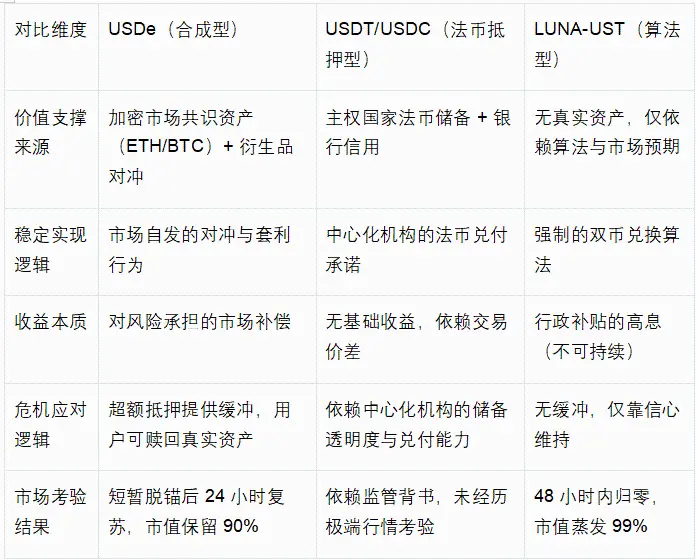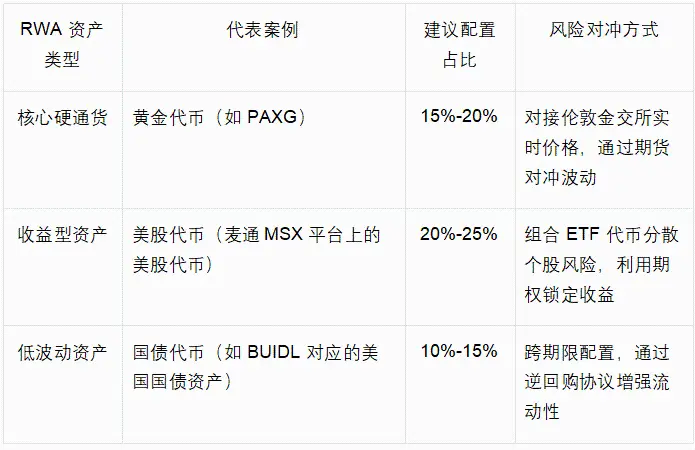Mai Tong MSX Research: The same stablecoin is depegged, why does USDe survive and LUNA returns to zero?
intersection of the October 2025 depegging event and Hayek's prediction
On October 11, 2025, panic in the crypto market triggered an extreme shock to the synthetic stablecoin USDe - USDe fell to about $0.65 (down about $1 from $1 in a single day) in the "epic crash" in which Bitcoin plummeted from $117,000 to $105,900 (down 13.2% in a single day) and Ethereum plummeted by 16% in a single day 34%), followed by recovery within hours. During the same period, the 24-hour liquidation volume of the global crypto market soared to $19.358 billion, and 1.66 million traders were forced to close their positions, setting a record for the largest single-day liquidation in history.
From the perspective of micromarket performance, the USDe-USDT liquidity pool depth on the decentralized exchange Uniswap was only $3.2 million at the peak of the event, a decrease of 89% from before the event, resulting in a 25% discount on 100,000 USDe sell orders due to slippage (pending order of $0.7, actual transaction price of $0.62). At the same time, six leading market makers face the risk of liquidation of margin value by 40% due to the use of USDe as cross-margin, further exacerbating the black hole of market liquidity.
However, this "crisis" ushered in a key reversal within 24 hours: the price of USDe gradually recovered to $0.98, and the third-party proof of reserves disclosed by Ethena Labs showed that its collateral ratio remained above 120%, and the overcollateralization scale reached $66 million; More importantly, the user redemption function is always normal, and the assets such as ETH and BTC in the collateral can be cashed out at any time, which has become the core support for market confidence repair.
According to the McStone MSX Research Institute, this "plunge-recovery" curve contrasts sharply with the outcome of LUNA-UST completely zeroing out after the depegging of LUNA-UST in 2022, and also puts this event beyond the ordinary "stablecoin volatility" category - it became the first extreme stress test of Hayek's theory of "denationalization of money" in the digital age.
In 1976, Hayek proposed in "The Denationalization of Money" that "money, like other commodities, is best offered by private issuers through competition rather than by government monopolies." He argues that the government's monopoly on money issuance "is the root cause of all the ills of the monetary system," and that the biggest problem with the monopoly mechanism is that it hinders the process of discovering a better form of money. Under the competitive framework he envisioned, privately issued currencies must maintain stable purchasing power or be eliminated by the market due to loss of public trust; As a result, competing currency issuers "have a strong incentive to limit their numbers or lose their business."
Half a century later, the emergence of USDe reflects the contemporary expression of this idea. It does not rely on sovereign fiat currency reserves, but is supported by crypto market consensus assets and maintains stability through derivatives hedging. Regardless of the outcome of the de-anchoring and recovery in October 2025, the practice of this mechanism can be seen as a real-world experiment of Hayek's "competition to discover high-quality money" - it not only verifies the potential self-regulation power of the market in monetary stability, but also reveals the institutional resilience and evolution direction of digital private currencies in a complex environment.
USDe's mechanism innovation
USDe's "collateral-hedging-income" trinity structure, each link is permeated with the logic of spontaneous market regulation, rather than the coercive constraints of centralized design, which is highly consistent with Hayek's emphasis that "market order arises from individual spontaneous actions".
Collateral system: the value base built by market consensus
USDe's collateral selection fully follows the liquidity consensus of the crypto market - ETH and BTC together account for more than 60%, and these two assets are not designated by any institution, but have been recognized by global investors as "hard assets in the digital world" in more than a decade of trading. Auxiliary liquid staking derivatives (WBETH, BNSOL, etc.) are also spontaneous products of the market to improve capital efficiency, which can not only retain staking income without sacrificing liquidity; USDT/USDC, which accounts for 10%, is the "transitional stability tool" chosen by the market, providing a buffer for USDe in extreme market conditions.
Theentire collateral system has always maintained an excess state, and the collateral ratio is still over 120% at the time of the incident in October 2025, and it is valued and automatically cleared by smart contracts in real time.
Stability mechanism: Spontaneous hedging in the derivatives market
Thecore difference between USDe and traditional fiat-backed stablecoins is that they do not rely on "fiat currency reserves backed by national credit", but achieve risk hedging through short positions in the derivatives market. The essence of this design is to use the liquidity of the global crypto derivatives market to allow the market itself to absorb price fluctuations - when the price of ETH rises, the profit of the spot asset offsets the short loss; When the price of ETH falls, the shorts' profits make up for spot losses, and the entire process is completely driven by market price signals without any centralized institutional intervention.
When ETH plummeted by 16% in October 2025, this hedging mechanism did not fail despite a brief lag due to instant liquidity depletion - the short positions held by Ethena Labs eventually generated a floating profit of $120 million, which did not come from administrative subsidies, but from voluntary transactions between long and short sides in the derivatives market.
Yield mechanism: Spontaneous incentives to attract market participation
The "pledge income + revolving lending" model designed by USDe is not a "rigid payment of high interest rates" in traditional finance, but a reasonable compensation for market participants to bear risks. The basic 12% annualized subsidy comes from the spontaneous investment of ecological funds in "improving the circulation of money"; The mechanism of magnifying leverage to 3-6 times and annualized returns of 40%-50% through revolving lending is essentially to allow users to choose the match between risk and return independently - users who are willing to bear higher leverage risks can obtain higher returns; Users with low risk appetite can choose basic staking.
Comparison of Mechanisms of Three Stablecoins: The Division of Market Choice and Administrative Intervention
 -- The
-- The
Truth > Market Test: Why USDe Can Draw a Clear Line with LUNA-UST
The October 2025 de-anchor event is often misunderstood as the "same kind of risk exposure" between USDe and LUNA-UST, but from the perspective of the Austrian school, the essential difference between the two is completely highlighted in this test - the recovery of USDe is the success of "non-national currencies tested by the market", while the collapse of LUNA-UST is the inevitable outcome of "pseudo-innovation away from real assets".
Theessential difference in value anchors: real assets vs. nihilistic expectations
Thevalue anchor of USDe is real assets such as ETH and BTC that can be cashed out at any time, and even in extreme market conditions, users can still obtain equivalent crypto assets through the redemption mechanism - during the depegging in October 2025, USDe's redemption function will always operate normally, and third-party proofs of reserves show that it is overcollateralized by $66 million, and this "cashable value promise" is the foundation of market confidence.
LUNA-UST, on the other hand, is not backed by any real assets, and its value is entirely dependent on "user expectations for the price of LUNA." When market panic broke out, UST's exchange mechanism needed to be realized by issuing additional LUNA, and the unlimited additional LUNA eventually lost value, causing the entire system to collapse. This "asset-backed currency" has violated Hayek's principle that "money must have a real value base" from its inception, and collapse is an inevitable result.
Logical differences in crisis response: spontaneous market repair vs. administrative intervention failure
USDe's response after unanchoring completely follows the market logic: Ethena Labs did not issue an "executive order-style bailout plan", but sent a signal to the market of "mechanism transparency and asset security" by disclosing proof of reserves, optimizing the collateral structure (reducing the proportion of liquid pledge derivatives from 25% to 15%), and limiting leverage multiples. Ultimately, it relies on the user's spontaneous trust to achieve price repair.
LUNA-UST's response to the crisis is a typical "failure of administrative intervention": the Luna Foundation Guard tried to rescue the market by selling Bitcoin reserves, but this centralized operation could not resist the spontaneous sell-off in the market - Bitcoin itself also fell in extreme market conditions, and the reserve assets were highly bound to UST risks, and the bailout ultimately failed.
Differences in long-term vitality: market adaptability vs. mechanism vulnerability
USDe not only recovered its price after depegging, but also improved its long-term adaptability through mechanism optimization: limiting the leverage of circular lending to 2x, introducing compliant treasury bond assets (USDtb) to improve collateral stability, and diversifying hedging positions across exchanges - these adjustments do not come from executive orders, but are spontaneous responses to market feedback, making the mechanism more in line with the market law of "risk-return matching".
LUNA-UST lacks market adaptability from the beginning: its core Anchor protocol has a high interest rate of 20%, relying on continuous subsidies from ecological funds rather than real payment needs (UST's real payment scenarios account for less than 5%). When subsidies cannot be sustained, the capital chain breaks and the entire system collapses in an instant. This model of "relying on unsustainable administrative subsidies" is destined to not survive in market competition for a long time.
Mechanism flaws and critical reflection: the dilemma of the growth of non-state currencies
Theinnovative value of USDe is undeniable, but in the stress test and daily operation in October 2025, its mechanism design still deviates from Hayek's concept of "complete market spontaneous regulation", exposing risks and hidden dangers that need to be vigilant.
Collateral concentration risk: The systematic binding of USDe in the crypto asset cycle
Morethan 60% of USDe's collateral is concentrated in ETH and BTC, which is in line with the current liquidity consensus in the crypto market, but it is trapped in the dilemma of "single market cycle binding". The de-anchoring in October 2025 was essentially a ripple effect triggered by a unilateral decline in the crypto market - when ETH plummeted by 16% in a single day, the instantaneous shrinkage in collateral market capitalization, even with derivatives hedging, still caused market panic.
What is even more alarming is that the current liquid staking derivatives (WBETH, etc.) in the secondary collateral have not yet been separated from the Ethereum ecosystem, which is essentially a "secondary derivative of crypto assets" and fails to achieve true risk diversification. This collateral structure of "internal circulation of crypto assets" is still fragile compared to the logic of traditional money relying on the value of the real economy.
Limitations of hedging mechanisms: Centralized exchanges implicitly rely on
USDe for derivatives hedging is highly dependent on the liquidity of leading centralized exchanges, and the brief lag of the hedging mechanism in October 2025 is precisely due to the liquidity fault caused by the suspension of perpetual contract trading by a leading exchange. USDe's current short positions are concentrated on two exchanges, making it difficult to completely move away from passive acceptance of centralized platform rules.
In addition, the sharp fluctuations in funding rates exposed the singleness of the hedging tool. USDe currently relies only on perpetual contracts for risk hedging and lacks a combination of options and futures, making it difficult to quickly adjust hedging strategies when long and short forces are extremely imbalanced, reflecting that its mechanism design has not fully utilized the market's multi-risk pricing capabilities.
RWA Anchor Upgrade: The Advanced Path of Non-National Currencies
In the face of existing mechanical flaws, integrating into the optimized anchoring system of RWA assets such as gold tokens and US stock tokens is not only a precise correction of USDe shortcomings, but also an inevitable choice in line with the explosive trend of the RWA market (reaching US$26.4 billion in 2025, an annual increase of 113%). This upgrade is not a departure from the core of non-nationalization, but by docking the value of the real economy, Hayek's concept is more vital in the digital age.
Theunderlying logical currency value anchored by RWA
should come from the real assets of broad market consensus, and RWA assets have exactly this attribute - gold, as a thousand-year hard currency, has a value consensus that transcends countries and eras; U.S. stock tokens correspond to the real economic income of listed companies, anchoring the ability of enterprises to create value; Treasury bond tokens rely on the tax power of sovereign countries to provide a low-volatility value benchmark. The value of these assets does not depend on crypto market cycles, but comes from real-world production and trading, which can build a "cross-market value buffer" for USDe.
Thecore difference between BUIDL and USDe is that BUIDL relies on centralized institutional issuance, while USDe can realize decentralized confirmation and valuation of RWA assets through smart contracts, truly practicing the logic of "spontaneous market management".
Adaptation and Allocation Strategy for Diversified RWA Assets
USDe's RWA anchoring upgrade should follow the principle of "market consensus first, risk diversification adaptation", combined with the current RWA tokenization maturity, to build a "core-auxiliary-elastic" three-layer allocation system, as shown in the following table:

This configuration can reduce the proportion of crypto asset collateral in USDe from the current 80% to 40%-50%, retaining the liquidity advantage of the crypto market while achieving cross-market risk diversification through RWA assets. Taking gold tokens as an example, their price correlation with ETH is only 0.2, which can act as a "value anchor" when the crypto market falls, avoiding the concentrated selling panic in October 2025.
There-enlightenment of the Austrian School: the evolutionary logic from innovation to maturity
The flaws of USDe and the RWA upgrade path further confirm the deep connotation of Hayek's "Denationalization of Currency": denationalized currency is not a static mechanism design, but a dynamic market evolution process, and only through continuous self-correction and innovation can it win in currency competition.
The evolution of the value base: From a single market consensus to cross-domain value pegging
USDe The current crypto asset collateral is the "primary form" of non-state currencies in the digital age - its value consensus is limited to crypto market participants. The essence of integrating RWA assets is to expand the value consensus to the traditional finance and real economy, upgrading the value base of USDe from "digital consensus" to "cross-domain real value". This evolution is fully in line with Hayek's assertion that "currency value should come from the broadest market trust", and when USDe is anchored to multiple assets such as crypto assets, gold, and US stocks at the same time, its ability to resist the risks of a single market will be significantly improved, truly becoming a "carrier of value beyond sovereignty and a single market".
Improvement of the adjustment mechanism: from a single instrument to multiple market synergy
The current hedging mechanism of USDe relies on a single derivatives market, which is a manifestation of "insufficient utilization of market instruments". Hayek's emphasis on "market self-healing" should be based on multi-market synergy - the integration of RWA assets not only enriches collateral but also creates a synergistic hedging possibility of "crypto derivatives market + traditional financial market". For example, the volatility of U.S. stock tokens can be hedged through traditional stock options, while gold tokens can be connected to forward contracts in the London gold market, making the hedging mechanism more resilient and avoiding reliance on single market liquidity.
Conclusion: From Innovation Benchmark to Evolution Paradigm The
market test in October 2025 not only verifies the value of USDe as a benchmark for innovation in non-state currencies, but also reveals its inevitable path of evolution from "primary innovation" to "mature currency". The essential difference between it and LUNA-UST lies in its real value support and market regulation capabilities. Its current mechanism flaws are the inevitable growth costs in the innovation process.
The Mate MSX Research Institute believes that the upgrade strategy of integrating RWA assets such as gold tokens and US stock tokens provides a clear evolutionary direction for USDe - this is not a denial of existing innovations, but a deepening and improvement guided by Hayek's philosophy.
For market participants, the evolution of USDe has brought more profound enlightenment: the core competitiveness of non-state currencies lies not only in the courage to break sovereign monopolies, but also in the ability to continuously correct themselves; The criterion for judging its value is not only short-term stable performance, but also the resilience to connect with real value and adapt to market evolution in the long term. When USDe completes the RWA upgrade, it will no longer be just an innovative experiment in the crypto market, but a "cross-domain value carrier" that truly has the potential to challenge the traditional monetary system.
